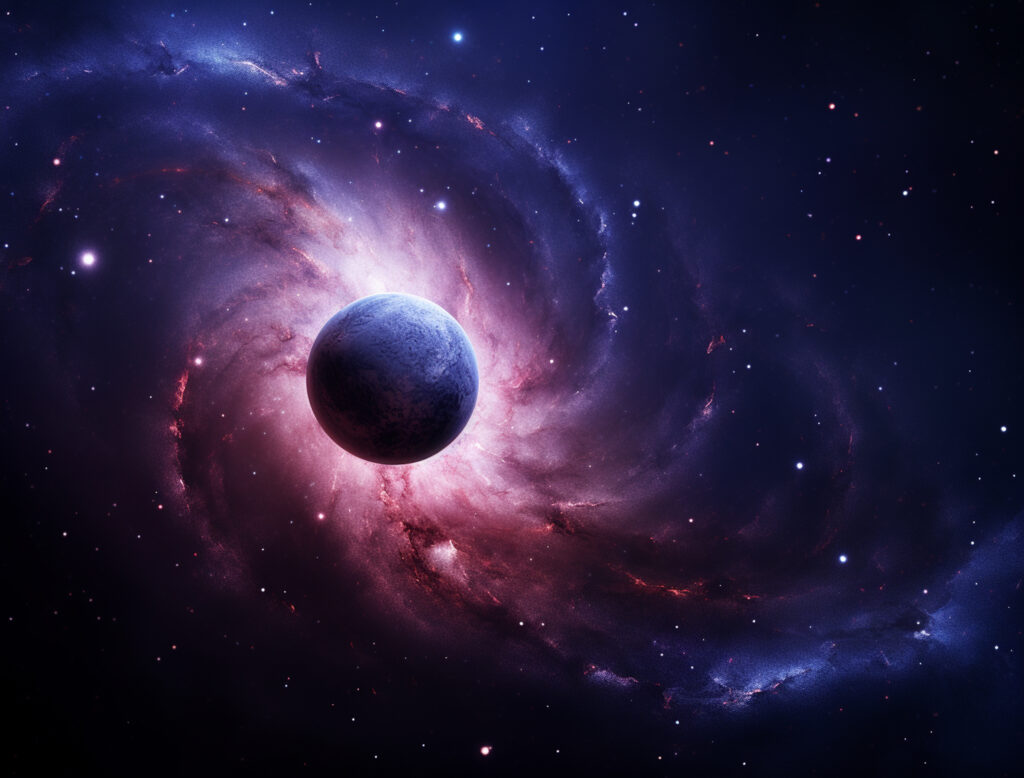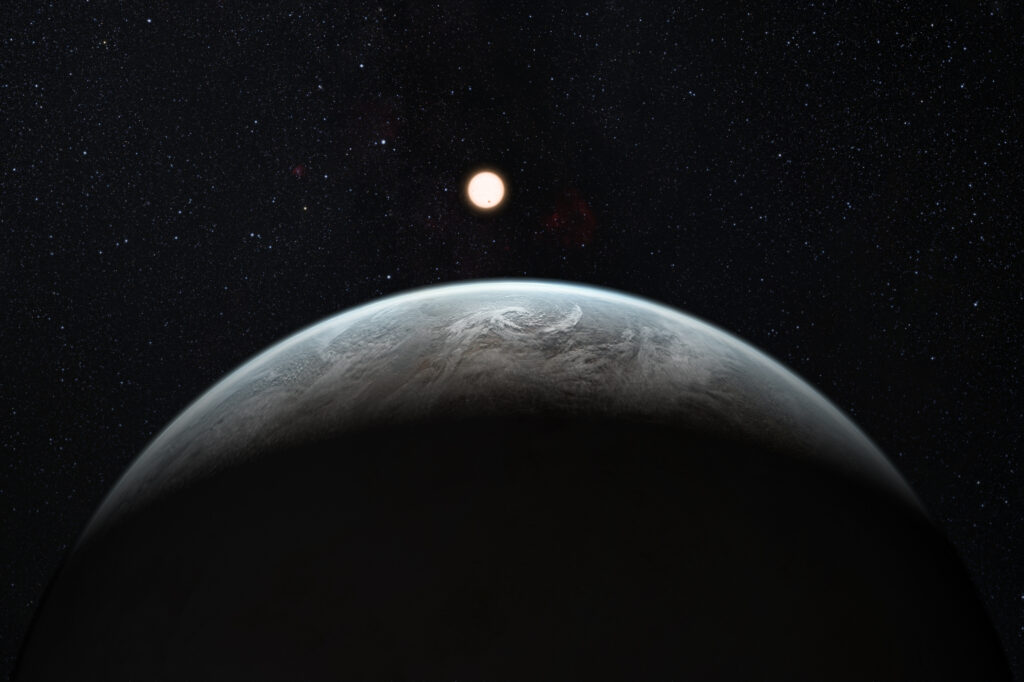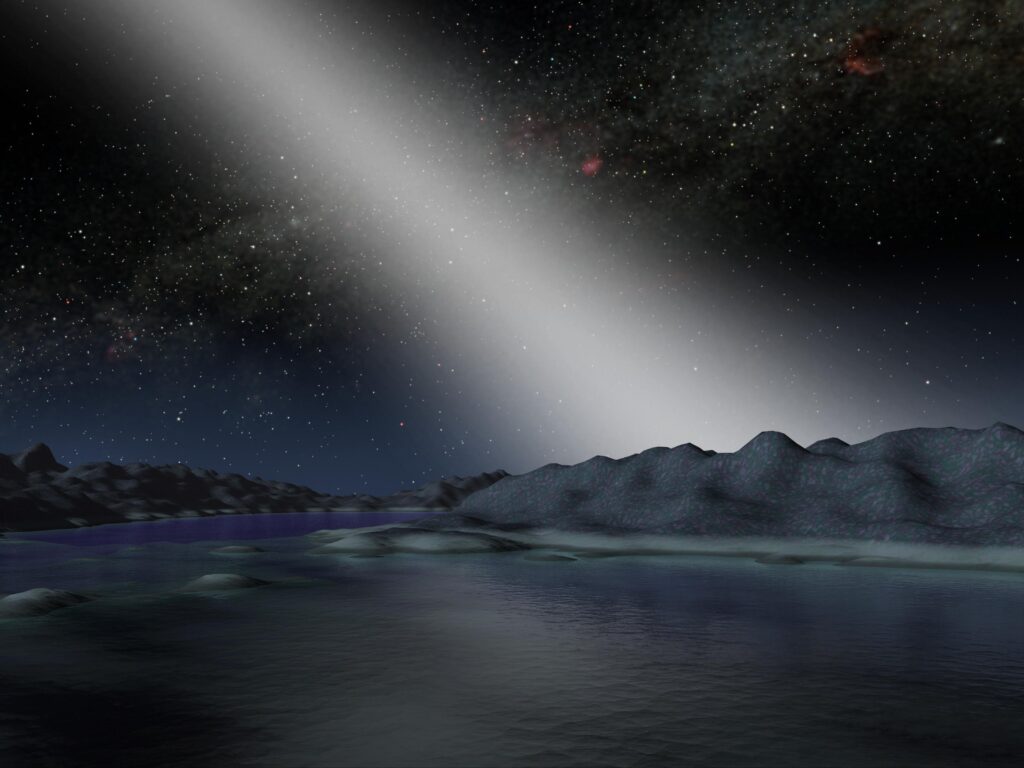Unraveling the Mysteries of the Hypothetical Planet
© NASA/Caltech/R. Hurt (IPAC)
In the boundless expanse of our solar system, mysteries persist, and the pursuit of knowledge knows no end. Often referred to as Planet Nine or Planet X, this theoretical celestial body is believed to inhabit the outer reaches of the Solar System. Its gravitational influence potentially accounts for the intriguing clustering of orbits observed among a group of distant trans-Neptunian objects (ETNOs) that orbit the Sun at distances averaging over 250 times that of Earth.
Originally postulated, this hypothesized Super-Earth sized planet was anticipated to possess a mass ranging from five to ten times that of Earth, with an elongated orbit situating it 400 to 800 times farther from the Sun than Earth.
In 2021, the precision of the orbit calculation was honed, yielding a somewhat smaller semimajor axis of 380+140−80 astronomical units (AU). This figure was subsequently adjusted to 460 +160−100 AU. Konstantin Batygin and Michael Brown posit that Planet X could be the remnant core of a colossal planet that was displaced from its initial orbit by the gravitational influence of Jupiter during the formation of the Solar System. Alternatively, other theories suggest that the planet may have been captured from another stellar system, once roamed the cosmos as a rogue planet, or formed in a distant orbit and was later drawn into an eccentric trajectory by the gravitational pull of a passing star.
EVIDENCE

The existence of Planet X, a hypothetical ninth planet in our solar system, is still unconfirmed. However, astronomers have gathered compelling indirect evidence that suggests the presence of such a planet. These lines of evidence, though not definitive, have sparked significant interest and ongoing research.
ORBITAL ANOMALIES OF KUIPER BELT OBJECTS
One of the most significant pieces of evidence comes from the observed orbital anomalies of certain Kuiper Belt Objects, particularly those in highly elongated and inclined orbits. These KBOs exhibit clustering in their orbital parameters, which could be explained by the gravitational influence of a massive, distant planet.
ALIGNMENT OF PERIHELION DIRECTIONS
Studies have shown that the perihelion (closest approach to the Sun) directions of several distant KBOs are clustered, suggesting that a massive perturbing body, like Planet X, might be shepherding them into this alignment.
ELONGATION OF ORBITS
The observed elongation of orbits for some KBOs, along with their inclination, could be explained by the presence of a massive planet, which gravitationally scatters and elongates its orbits over long periods.
COMPUTER SIMULATIONS
Numerical simulations of the solar system’s evolution, incorporating the hypothetical presence of Planet X, have successfully reproduced the observed clustering and alignment of KBO orbits, lending further support to the idea.
INFLUENCE ON INNER SOLAR SYSTEM OBJECTS
The gravitational influence of Planet X, if it exists, could extend to the inner solar system. This hypothetical planet’s presence might explain certain orbital anomalies in the orbits of distant asteroids and other inner solar system objects.
ANALYSIS OF CASSINI DATA
Some researchers have analyzed data from the Cassini spacecraft’s mission to Saturn to investigate potential gravitational interactions between the proposed Planet X and Saturn’s moon, Iapetus.
ORBITAL CHARACTERISTICS

Planet X, a hypothetical ninth planet in our solar system, is thought to possess distinct and intriguing orbital characteristics that set it apart from the known planets. While it has not been directly observed, extensive simulations and studies suggest certain orbital parameters that align with the observed anomalies of distant objects in the solar system. Here are the proposed orbital characteristics of Planet X:
ORBITAL DISTANCE (SEMI-MAJOR AXIS)
The semi-major axis of Planet X’s orbit is believed to be exceptionally distant from the Sun, far beyond the orbits of the known eight planets. Current estimates place it at roughly 400 to 800 astronomical units (AU) from the Sun. One AU is the average distance between Earth and the Sun, approximately 93 million miles (150 million kilometers).
ORBITAL ECCENTRICITY
Planet X’s orbit is thought to be highly eccentric, meaning it is significantly elongated rather than nearly circular. This high eccentricity contributes to its unique gravitational influence on distant objects in the solar system.
ORBITAL INCLINATION
The inclination of Planet X’s orbit is expected to be inclined relative to the plane of the solar system, possibly tilted by several degrees. This inclination could contribute to the observed clustering of distant object orbits.
ORBITAL ORIENTATION
The orientation of Planet X’s orbit is theorized to be perpendicular or nearly perpendicular to the plane of the solar system, which differs from the orbits of the known planets, which lie relatively close to the solar system’s plane.
ORBITAL PERIOD
Due to its vast distance from the Sun, Planet X is predicted to have an incredibly long orbital period, potentially ranging from 10,000 to 20,000 years or more. This extended orbit would explain why it has remained elusive to direct observation.
GRAVITATIONAL INTERACTIONS
Planet X’s proposed orbit is believed to be responsible for the gravitational perturbations observed in the orbits of distant Kuiper Belt Objects (KBOs). These perturbations have led to the clustering and alignment of certain KBO orbits.
POSSIBLE RESONANCE WITH OTHER OBJECTS
Some studies suggest that Planet X’s orbit may be in resonance with other distant objects or that it may have its resonant behaviour concerning the known planets. The specific resonance ratios are still a subject of study.
FORMATION AND MIGRATION

The hypothetical Planet X, believed to be a distant and massive world in the outer solar system, has generated considerable interest among astronomers and planetary scientists. While its existence is yet to be confirmed through direct observation, researchers have proposed intriguing theories about how such a planet might have formed and migrated to its current hypothetical position. Here, we explore some of the leading hypotheses regarding the formation and migration of Planet X:
FORMATION IN THE SOLAR NEBULA
One theory posits that Planet X, like other planets in the solar system, originated from the protoplanetary disk, also known as the solar nebula. Within this disk of gas and dust surrounding the young Sun, solid planetesimals gradually coalesced to form planetary embryos.
DISTANT FORMATION LOCATION
It is proposed that Planet X may have formed at a relatively large distance from the Sun compared to the inner planets. This distant formation location could explain its current position in the outer solar system.
INTERACTION WITH GIANT PLANETS
Gravitational interactions with the giant planets, particularly Jupiter and Saturn, may have played a crucial role in Planet X’s migration. These interactions could have perturbed its orbit and caused it to move outward from its formation location.
SCATTERING BY JUPITER AND SATURN
The presence of Jupiter and Saturn could have scattered Planet X through a process known as gravitational scattering. This scattering effect would gradually push the planet to more distant orbits.
RESONANT BEHAVIOUR
Some hypotheses suggest that Planet X may have been in resonance with the giant planets at certain points in its history. These resonant interactions could have influenced its migration, causing it to move farther from the Sun.
CAPTURE FROM THE SUN’S BIRTH CLUSTER
An alternative theory proposes that Planet X may not have formed in our solar system at all but could have been captured from the Sun‘s birth cluster of stars when it was still young. Such a captured planet would have unique characteristics compared to native solar system objects.
ROLE IN SOLAR SYSTEM DYNAMICS
The presence of Planet X, if confirmed, may have had a significant impact on the overall dynamics of the solar system. Its gravitational influence on distant objects, such as Kuiper Belt objects and comets, could explain observed orbital anomalies.
INFLUENCE ON KUIPER BELT OBJECTS
Planet X’s migration and gravitational influence on Kuiper Belt Objects (KBOs) could have shaped the structure and orbital characteristics of the Kuiper Belt, leading to the observed clustering and alignment of certain KBOs.
ELUSIVE NATURE
One reason Planet X remains elusive is its vast distance from the Sun, combined with its long orbital period. Its slow movement across the sky and its location near the galactic plane make it challenging to detect using current observational methods.
PLANET X’S ROLE IN THE OUTER SOLAR SYSTEM

Planet X, if it exists, is believed to play a significant and fascinating role in the dynamics of the outer solar system. Its hypothetical presence has been proposed to explain various observed anomalies and patterns among distant objects and phenomena in this remote region. Here are some key aspects of Planet X’s role in the outer solar system:
ORBITAL ANOMALIES OF KUIPER BELT OBJECTS
One of the primary reasons for postulating the existence of Planet X is to account for the unusual clustering and alignment of certain Kuiper Belt Objects (KBOs). These distant objects exhibit orbital anomalies that are challenging to explain without the gravitational influence of a massive, distant planet. Planet X’s presence could help resolve these peculiarities.
MAINTAINING STABILITY IN THE KUIPER BELT
The gravitational perturbations caused by Planet X could contribute to the long-term stability of the Kuiper Belt. By shepherding objects and maintaining resonances, it may play a role in sculpting the overall structure and composition of this distant region.
EXPLANATIONS FOR PERIHELION CLUSTERING
Planet X may be responsible for the clustering of perihelion directions (closest approach to the Sun) among certain distant objects. Its gravitational pull can help align these orbits and explain why they exhibit similar perihelion angles.
INFLUENCE ON DISTANT COMETS
Planet X’s influence extends to the realm of comets, including long-period comets. It may serve as a source of perturbations that send comets on distant, elliptical orbits toward the inner solar system. Understanding these perturbations can improve predictions of comet arrivals.
ROLE IN THE SCATTERING DISK
The scattering disk is a region beyond the Kuiper Belt where certain objects, like Sedna and 2012 VP113, have highly eccentric orbits. Planet X’s gravitational interaction may have played a role in scattering these objects to their current positions.
CAPTURE AND RESONANCE
Some theories suggest that Planet X might be in resonance with other distant objects, creating stable patterns within the outer solar system. Additionally, its potential capture into resonant orbits with Neptune could have influenced its migration and the orbits of other distant bodies.
IMPACT ON INNER SOLAR SYSTEM OBJECTS
While the primary influence of Planet X is in the outer solar system, it may have subtler effects on the inner solar system, particularly on the orbits of distant asteroids and other objects.
HYPOTHETICAL CHARACTERISTICS

The hypothetical characteristics of Planet X are based on theoretical models and simulations aimed at explaining its potential existence and gravitational influence on the outer solar system. While these characteristics are speculative, they provide a framework for astronomers and planetary scientists to guide their search and observations. Here are some of the hypothetical characteristics of Planet X:
MASS
Planet X is believed to be a massive planet, possibly several times the mass of Earth. Its substantial gravitational influence is necessary to explain the observed perturbations of distant objects in the solar system.
SURFACE CHARACTERISTICS
The surface of Planet X, if it exists, would be shrouded in mystery. Its extremely remote location and low-temperature likely result in a frigid and desolate surface, possibly covered in icy and rocky materials.
COMPOSITION
Planet X’s composition remains uncertain, but it is likely composed of a mixture of ice, rocky materials, and possibly volatile compounds. Its composition would depend on its formation history and location in the solar system.
POSSIBLE MOONS
Hypothetically, Planet X might have one or more moons orbiting it. These moons, if they exist, could provide valuable clues about the planet’s characteristics and formation.
GRAVITATIONAL INFLUENCE
The primary role of Planet X, if confirmed, is its gravitational influence on distant objects in the solar system. It would explain the observed anomalies in the orbits of Kuiper Belt Objects (KBOs) and other outer solar system bodies.
ELUSIVE NATURE
The hypothetical Planet X has remained elusive due to its extreme distance and slow motion across the sky. Detecting it directly is a significant challenge, and researchers rely on indirect evidence and observations of its gravitational influence.
PLANET X AND BEYOND

The quest to unveil the mysteries of our solar system knows no bounds, and at the heart of this cosmic journey lies the enigmatic Planet X. While its existence remains unconfirmed, the pursuit of this hypothetical celestial giant is a testament to humanity’s unyielding curiosity and dedication to understanding the cosmos.
Beyond the tantalizing intrigue of Planet X, our solar system continues to reveal its secrets through the study of distant worlds, dynamic orbits, and the celestial wonders that beckon us to explore further. Each discovery, whether on the outer reaches of our solar system or the depths of interstellar space, invites us to expand our knowledge, reshape our understanding, and embrace the infinite possibilities that the cosmos holds.
The hypothetical Planet X, a hidden giant lurking in the outer reaches of our solar system, remains one of the most tantalizing mysteries of our cosmic neighbourhood. While its existence has not yet been confirmed through direct observation, the compelling evidence derived from orbital anomalies and theoretical models has left an indelible mark on planetary science.
Planet X embodies the spirit of exploration and curiosity that drives astronomers and scientists to push the boundaries of knowledge. Its potential existence challenges our understanding of the solar system’s dynamics, formation, and history, inviting us to envision new scenarios of planetary migration and gravitational influence.
As we continue to peer into the depths of space, armed with ever-advancing telescopes and mathematical tools, the quest for Planet X is a reminder that the cosmos is replete with hidden wonders, and the pursuit of knowledge knows no bounds.
Whether it takes the form of a distant world or an enigmatic concept, the quest for understanding remains the guiding light of our exploration of the universe. Planet X and its mysteries, whether confirmed or not, have left an indelible mark on our scientific journey, inspiring future generations to continue the search for the cosmic enigmas that await discovery.
